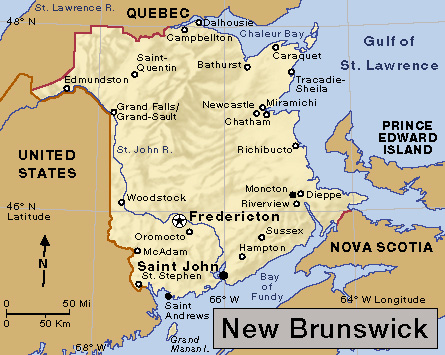Saint John (pop. 69,895; met. area pop. 130,613) is one of the largest cities of New Brunswick and its leading industrial center. It also ranks as a major Canadian port. Saint John Harbour remains open all winter, when ice closes Canada’s inland ports. The city lies on the Bay of Fundy, at the mouth of the Saint John River.

Saint John is called the Loyalist City because it was founded by Americans known as United Empire Loyalists. These people moved to Canada because of their support for Britain (now also called the United Kingdom) during the Revolutionary War in America (1775-1783). In 1783, about 4,000 of them sailed from New England to the site of Saint John, where they had been granted land because of their loyalty to Britain. In 1785, the Loyalist communities of Parrtown and Carleton merged to form Saint John, which then became the first incorporated city in Canada. The city was named for the Saint John River. The French explorer Samuel de Champlain had named the river in honor of Saint John the Baptist. Champlain reached the waterway on the saint’s feast day, June 24, in 1604.
Description.
Saint John covers 122 square miles (316 square kilometers). Its metropolitan area covers 1,354 square miles (3,506 square kilometers). Much of the city lies on peninsulas. Saint John is the home of the New Brunswick Museum, the oldest museum in Canada. This museum was established in 1842. Saint John also has a branch campus of the University of New Brunswick.
The city’s most famous tourist attraction is the Reversing Falls, at the mouth of the Saint John River. Here, high tides from the Bay of Fundy force the river backwards through the falls twice a day. Historic attractions in Saint John include the Carleton Martello Tower, a stone fortification built during the War of 1812 (1812-1815); the Loyalist House, a home completed in 1817; and the City Market building, which opened in 1876.
Saint John has dozens of manufacturing plants. The main industries include oil refining and pulp and paper manufacturing. In addition, the city is a busy port. An offshore terminal nearby serves huge oil tankers. Railroads provide freight and passenger service for the city. Airlines use Saint John Airport.
Government and history.
Saint John has a council-manager form of government. The voters elect a mayor and 10 council members to four-year terms. An appointed city manager serves as the chief administrative official of the city government.
Maliseet (also called Wolastoqiyik) Indians lived in what is now the Saint John area before Europeans arrived. By 1631, French fur traders had built a fort there. Rival French traders and the British fought over the area. The British finally won control in 1755.
The area remained largely a wilderness until the United Empire Loyalists arrived in 1783. Many of the early residents built or operated wooden sailing ships. By the mid-1800’s, Saint John had one of the world’s largest merchant fleets. In the late 1800’s, the increasing use of iron steamships led to the decline of Saint John’s sailing-ship industry. The Great Fire of 1877 destroyed much of the city, but the people quickly rebuilt it. By 1900, Saint John had about 40,000 people.
The 1960’s brought a new period of growth to Saint John. Corporations established or expanded many large facilities, including an oil refinery, paper mills, ship terminals, and shipyards. In 1969, the city’s population jumped from 51,567 to 89,039 when Saint John merged with the city and the parish of Simonds.
In 1974, the city began a downtown reconstruction program. The program focused on the development of Brunswick Square, a shopping center, hotel, and office complex. Brunswick Square was completed in 1981. In 1983, Market Square opened nearby. Market Square is a shopping, dining, and convention center. An adjoining hotel on the waterfront was completed in 1984. Other improvements included placing wiring underground, planting trees, and paving streets with red brick.
For the monthly weather in Saint John, see New Brunswick (Climate).
